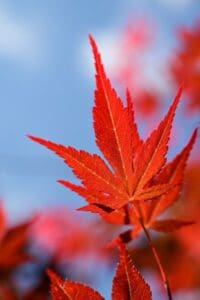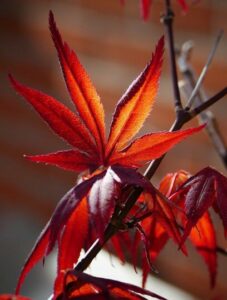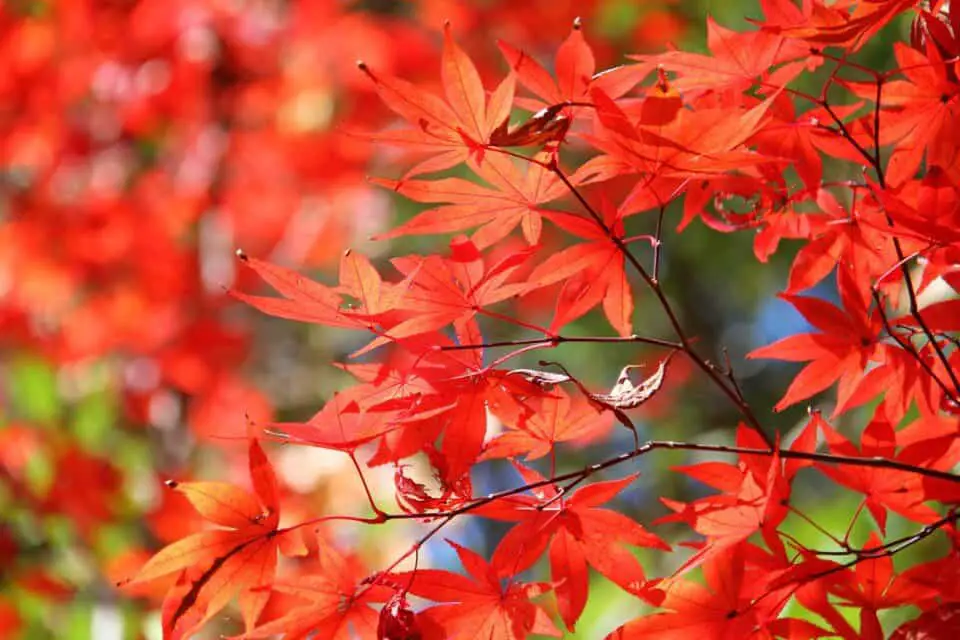Some links in the post are affiliate links and I get a commission from purchases made through some links found in the post.
Japanese maple or Acer Palmatum is native to Japan but also has been traced back to Korea, China, and Mongolia.
Due to its reddish hand-shaped leaves and corrugated trunk, it has been added as a wonderful addition to gardens and lawns.
Japanese maple have long been used in traditional medicine, so their benefits include skin treatment, liver and eye covering, and digestion properties along with it’s exterior beauty.
It also used to make the famous Chinese “Japanese maple tea and syrup”. People have been using the Japanese maple as a natural medicine since the 19th century.
The Japanese maple has many varieties, and each variety has a different structure of which the spread can reach up to 30 ft in height.
The plant needs a good amount of light to get the right color of the leaves. The Japanese maple thrives perfectly in a little moist and acidic soil.
Apart from this, the Japanese maple grows at an average rate. They grow faster as younger plants but the speed gradually slows down when they reach maturity.
A mature plant takes up to a year to grow 2 to 3 feet. Moreover, the lifespan of this plant is about 300 years with proper care.
Now, let’s study what an Acer plant offers us with its alluring beauty.
What are the Benefits of a Japanese maple?
1) Natural Wrinkles Treatment
 Japanese maple or Acer plants have Tannins in abundance. In general, Tannins is found in the tissues of the plant.
Japanese maple or Acer plants have Tannins in abundance. In general, Tannins is found in the tissues of the plant.
It is mainly responsible for maintaining the color of the plant, which embraces red, light pink, purple and green. Tannins isa complex chemical compound that helps to retain the quality of the skin.
Moreover, the red and sugar maple plant is considered by many scientists to treat wrinkles naturally.
According to the research, the plant helps in controlling the function of enzyme regulation. Are you still confused? Let me give you more insight into it.
In our body we have Elastin, a natural protein that helps to keep our skin in shape. But there is an enzyme, called elastase that breaks down this protein and causes wrinkles, and leads to aging skin.
Now, when you use an extract from the red maple from its Summer and fall leaves, it creates a barrier for the enzyme and stops its functioning.
That brings us tight skin as a result. Moreover, the best way to use it for skin care is to mix the extract of the maple tree with any other skincare product to get the required result.
But that’s not all. Research also has shown that red maple extract helps in healing dark spots and other skin inflammation.
You may also like: Japanese maple vs red maple
2) Japanese Maple Food Benefits
In Japan, it has been used as a tea but not all varieties of Japanese maple, only some of them, such as red, sugar, and Nikko maple.
The primary reason for using a Japanese maple as tea is to have good health and to fulfil the nutrition of the body.
Moreover, sugar maple syrup is another thing to enjoy from it. The extract of the plant is mixed with boiled water, and to make it a thick texture. After that, use it over the food to add extra flavor.
It is an old tradition and is used in multiple ways in food. The USA, China, Canada, and Japan have been using it for centuries but in different ways. Maple syrup is famous in the USA. While tea has been on the top list in Japan.
3) Digestion Benefits
Japanese Maple or other Acer plants have another chemical compound called Flavonoids. This compound is found in the leaves, flowers, and stems of the plant.
Flavonoid is used to create a balance in health while maintaining the pathway of the digestive tract.
Acer plants tend to show antimicrobial effects. You must be wondering how exactly it works? Let me tell you more.
We have microbes in our digestive part which help us to digest our food. In case, these microbes got affected by some outside element, then Japanese maple can help to restore the balance.
Now, how much do you have to take and in what way? First of all, every plant has chemicals. Some of them are beneficial, others not.
The same rule applies to Japanese maple. The best way to intake a Japanese maple is to make tea.
Japanese maple tea has enough beneficial chemicals which can aid your health. Two things which you need to cope with.
First, never intake a large amount of the plant (directly). Secondly, do not use it for digestion until you are feeling it.
If you’re enjoying this article, check out our article on where should you plant a Japanese maple tree.
4) Liver Regulation
 Japan and Korea have been using the stems of the plant to conquer liver damage and disease. Moreover, the same function has been studied in China.
Japan and Korea have been using the stems of the plant to conquer liver damage and disease. Moreover, the same function has been studied in China.
By extracting the sap from the stem of the plant, and converting them into an oil or syrup to make it usable. Other medical techniques have also been used to make medicine out of it.
However, all of these methods are used to get an antioxidant, anti-inflammatory, and antimicrobial effect which helps to treat liver problems.
Moreover, the same practice has been followed to cure eye complications as well. Acer plant is used in Canada and Japan for eye agony.
Apart from these Japanese maple health benefits, scientists are still searching to find out more chemical functions of the plant. Another research has shown optimistic results for the treatment of tumors and many other bronchitis problems.
Similarly, another research has come up with the results that maple trees can be used for the treatment of diabetes. It helps in the regulation of the glucose in the body.
Moreover, Alzheimer’s has also been reviewed in this study. The work is done with the help of maple trees and “counteracting neuroinflammation” is the possible solution offered by the study.
5) Ornamental Feature
Whether you settle your Japanese maple in the soil of your garden or in a pot, it will complement your décor.
Due to its distinctive appearance and ease to take care of, it has been used to decorate gardens, backyards, lawns, and even a balconies and terraces.
Moreover, it is very easy to prune this plant in your required shape. You can easily convert the plant into a shape that will settle down with your other plants.
As it is found in red leaves, it opens more ways to come up with more creative ideas for your garden.
You may also like: Why is my Japanese maple turning brown
6) Wood Usage
Japanese maple wood is not hard enough to use easily in the making of the furniture but it is practiced in some areas.
Most importantly, its wood is flexible or soft to use in small decorative pieces. For instance, wooden jars and wall decorative pieces are easy to make with its wood.
Apart from this, Japanese maple benefits by using it in the manufacturing of drums, violins, and guitars. Similarly, baseball and cricket bats are also made from its wood.
Furthermore, for paper manufacturing, maple wood also plays a vital role.
You may also like: Why is your Japanese Maple Turning Green
Final Thoughts
 Japanese maple became popular among cultivators in the late 19th century. It has a very beautiful leaves which start as green leaves but converted into red, pink, purple, and yellow as the fall reaches.
Japanese maple became popular among cultivators in the late 19th century. It has a very beautiful leaves which start as green leaves but converted into red, pink, purple, and yellow as the fall reaches.
Moreover, its flower also have very exceptional feathers. The Japanese maple has flowers in the form of bands and has two pairs of five petals, one pair has white while the other stands in purple.
This distinctive beauty of the plant makes it best for the exterior décor. It doesn’t endure any serious plant disease, very unlikely for the other plants.
Moreover, its flowers also don’t attract insects unless it requires pollination. But mites and scales can give you a hard time. For this, you can use some spray or other home remedies to save your plant.
Lastly, the Japanese maple tree has no toxic or harmful effects on humans as well as on animals. Your pets can play around with the plant without any precautions (but do not let your pets or children intake the plant in a very large amount).
Apart from this, many studies have concluded that Japanese maple has negative effects on horses. The plant is considered toxic to horses.
The intake of Japanese maple by the horse affects the breathing system of the animal. In this case, without any delay, you have to call the expert.


